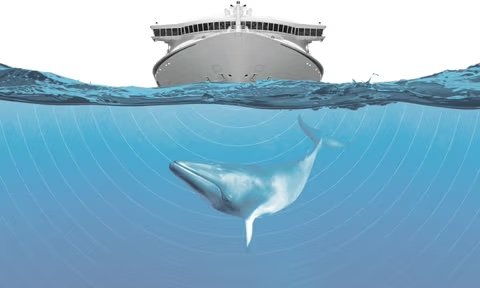Underwater Noise Pollution
Underwater Noise & the Marine Ecosystem
Underwater sound
Sounds generated underwater are louder (have more intensity) and travel faster than sounds instigated on land or above the surface of the water. Because of this speed, the source of underwater sounds can be difficult to locate. Noise can seem to surround the listener from all directions. Underwater sounds also maintain their loudness over longer distances. Whale songs can be heard by other whales thousands of miles away. Human activity has introduced a cacophony of noise into the marine environment. Human noise pollution (anthropogenic noise) can wreak havoc on marine ecosystems.
Noise pollution is a menace to humanity—and a deadly threat to animals.
Karen Bakker, The Guardian, 2023.
Sources
Marine mammals depend on their hearing to navigate, communicate, find food, and avoid danger. Underwater noise pollution can disorient marine mammals, mask their ability to hear important signals, and disrupt their normal feeding, breeding, and social behavior. Baleen Whales, such as the North Atlantic right whale, the humpback whale, and minke whales, hear sounds in a lower frequency range than the human ear.
Noise Pollution: The Soundscape of the Anthropocene Ocean
Duarte et al., Science, 2021.
Seismic Surveys
Seismic surveys use waves with more complexity and intensity. They also generally operate in a lower frequency range, the range used by many marine mammals. Seismic surveys can harm marine mammals and can destroy their food sources [1].
Widely used marine seismic survey air gun operations negatively impact zooplankton.
[1] McCauley, R.D., et al, Nature Ecology and Evolution, 2017.
Marine Mammals & Sound
Survival
Marine mammals depend on their hearing to navigate, communicate, find food, and avoid danger. Underwater noise pollution can disorient marine mammals, mask their ability to hear important signals, and disrupt their normal feeding, breeding, and social behavior. Baleen Whales, such as the North Atlantic right whale, the humpback whale, and minke whales, hear sounds in a lower frequency range than the human ear.
Communication
Marine mammals use sound to communicate with each other. Whale songs can travel over thousands of miles. Dolphins use sounds to cooperate with each other. Noise pollution can disrupt this communication and prevent dolphins from working together. An inability to cooperate may affect their survival.
Anthropogenic noise impairs cooperation in bottlenose dolphins
Sorensen et al., Current Biology, 2023
Sensitivity
Recently, scientists have discovered that minke whales, a species of baleen whale, can hear at a higher frequency than previously recognized. If minke whales can hear these signals, likely all baleen whales can too. Seismic surveys may disturb baleen whales more than we thought. We can no longer assume seismic surveys do not harm baleen whales.
Direct hearing measurements in a baleen whale suggest ultrasonic sensitivity
Houser et al., Science, 2024.
Does noise pollution harm marine mammals?
Avoidance
Whales, dolphins, and seals all avoid noisy areas, if they can. Whales will change their migration routes to avoid noise. Impulsive sounds, such as seismic surveys, can cause whales to rise to the surface more quickly than they should. This avoidance can lead to decompression sickness and ship strikes.
Stress Response
Chronic noise induces a stress response in marine mammals. Noise can raise stress hormones, reduce feeding, and disrupt breeding. North Atlantic right whales no longer grow to the same large size as their ancestors, and recently females have been taking twice as long to become pregnant (6 to 10 years) as they had previously (3 years)[1].
[1] NOAA, Biological Opinion for the Revolution Wind Project, 2024.
Unusual Mortality Events
An unusual rise in Humpback, Minke, and North Atlantic right whales deaths have occurred since 2016-2017. The timing of this rise correlates far more with offshore wind seismic activity than with any change in shipping activity. The National Marine Fisheries Service has recently admitted that a correlation between offshore wind seismic activity exists, although the agency has not been willing to properly investigate this association.
Does noise pollution harm other marine species?
Noise Pollution Affects Tuna
Scientists have demonstrated that underwater noise, including noise from operational wind farms can alarm, disorient, and cause bluefin tuna to avoid the source. Noise can also cause schools of tuna to swim in a disorganized and incoherent manner. Why does this matter? Coordinated swimming helps them survive and migrate. Disrupting this behavior could have long-term consequences on their survival.
Monitoring of caged Bluefin tuna reactions to ship and offshore wind farm operational noises.
Puig-Pons, V., et al., Sensors, 2021.
Cod Spawning
Cod use sounds to mate and lay eggs. They also display high site fidelity, meaning they return to the same spot every year to lay their eggs. If noise pollution has invaded their preferred spawning area, such as a new offshore wind project, they may not find another region to spawn. NOAA has warned BOEM that offshore wind developments threaten the survival of Southern New England cod.
Spawning dynamics and associated management implications for Atlantic Cod.
Zemeckis et al., 2014.
Invertebrates
Noise pollution will harm any species that is sensitive to sound. Most marine species use sound to survive, including invertebrates such as lobsters, crabs, mussels, and squid. Noise pollution disrupts feeding, can cause birth defects, and will even inhibit certain species from camouflaging themselves. We need to reduce noise pollution to preserve the health of the ocean.
Tracking Sea Creature Stress Related to Wind Turbine Construction
Skiles, 2024
Bam! Scientists study wind farm construction noise impacts on lobsters… by making big noises
Zuckoff, E., 2024












